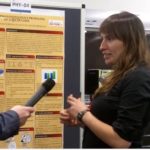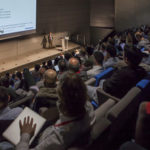In this video from PASC16, Annick V. Renevey from ETH Zurich describes her award-winning poster on peptide simulations at CSCS.
Video: Platform Independent Profiling of a QCD Code
“We present a procedure of implementing the intermediate profiling for openQCD code that will enable the global reduction of the cost of profiling and optimizing this code commonly used in the lattice QCD community. Our approach is based on well-known SimGrid simulator, which allows for fast and accurate performance predictions of the codes on HPC architectures. Additionally, accurate estimations of the program behavior on some future machines, not yet accessible to us, are anticipated.”
Interview: Peter Bauer from ECMWF at PASC16
In this video from PASC16, Peter Bauer from ECMWF shares his perspectives on the conference and his work with high performance computing for weather forecasting. “ECMWF specializes in global numerical weather prediction for the medium range (up to two weeks ahead). We also produce extended-range forecasts for up to a year ahead, with varying degrees of detail. We use advanced computer modeling techniques to analyze observations and predict future weather.”
Video: Nvidia’s Peter Messmer on Co-Design at PASC16
In this video from PASC16, Peter Messmer from Nvidia gives his perspectives on the conference and his work on co-design for high performance computing. “Using a combination of specialized rather than one type fits all processing elements offers the advantage of providing the most economical hardware for each task in a complex application. In order to produce optimal codes for such heterogeneous systems, application developers will need to design algorithms with the architectural options in mind.”
Context Matters: Distributed Graph Algorithms and Runtime Systems
In this video from the PASC16 conference, Andrew Lumsdaine from Indiana University presents: Context Matters: Distributed Graph Algorithms and Runtime Systems. “The increasing complexity of the software/hardware stack of modern supercomputers makes understanding the performance of the modern massive-scale codes difficult. Distributed graph algorithms (DGAs) are at the forefront of that complexity, pushing the envelope with their massive irregularity and data dependency. We analyze the existing body of research on DGAs to assess how technical contributions are linked to experimental performance results in the field. We distinguish algorithm-level contributions related to graph problems from “runtime-level” concerns related to communication, scheduling, and other low-level features necessary to make distributed algorithms work. We show that the runtime is an integral part of DGAs’ experimental results, but it is often ignored by the authors in favor of algorithm-level contributions.”
Challenges for Climate and Weather Prediction in the Era of Heterogeneous Architectures
Beth Wingate from the University of Exeter presented this talk at the PASC16 conference in Switzerland. “For weather or climate models to achieve exascale performance on next-generation heterogeneous computer architectures they will be required to exploit on the order of million- or billion-way parallelism. This degree of parallelism far exceeds anything possible in today’s models even though they are highly optimized. In this talk I will discuss the mathematical issue that leads to the limitations in space- and time-parallelism for climate and weather prediction models – oscillatory stiffness in the PDE.”
Simulations of Hydrogen Ingestion Flashes in Giant Stars
“My team at the University of Minnesota has been collaborating with the team of Falk Herwig at the University of Victoria to simulate brief events in the lives of stars that can greatly affect the heavy elements they synthesize in their interiors and subsequently expel into the interstellar medium. These events are caused by the ingestion of highly combustible hydrogen-rich fuel into the convection zone above a helium burning shell in the deeper interior. Although these events are brief, it can take millions of time steps to simulate the dynamics in sufficient detail to capture subtle aspects of the hydrogen ingestion. To address the computational challenge, we exploit modern multicore and many-core processors and also scale the simulations to run efficiently on over 13,000 nodes of NSF’s Blue Waters machine at NCSA.”
PASC16 Wraps in Lausanne
Scientists from a wide range of disciplines gathered at the SwissTech Convention Center in Lausanne from 8 to 10 June 2016 for this year’s PASC Conference. The use of high-performance computing in their research was the common bond that brought them together. From 8 to 10 June, the SwissTech Convention Center played host to around 360 scientists from Europe, the USA, Canada, Japan, Russia, Saudi Arabia, South Africa and Singapore, offering plenty of space and scope for them to engage in an interdisciplinary discourse on current issues relating to scientific computing.
Video: Extreme-Scale Multigrid Components within PETSc
In this video from the PASC16 conference, Patrick Sanan from USi Lugano & ETC Zurich presents: Extreme-Scale Multigrid Components within PETSc. “Elliptic partial differential equations (PDEs) frequently arise in continuum descriptions of physical processes relevant to science and engineering. Multilevel preconditioners represent a family of scalable techniques for solving discrete PDEs of this type and thus are the method of choice for high-resolution simulations.”
Chris Johnson Presents: Big Data Visual Analysis
“We live in an era in which the creation of new data is growing exponentially such that every two days we create as much new data as we did from the beginning of mankind until the year 2003. One of the greatest scientific challenges of the 21st century is to effectively understand and make use of the vast amount of information being produced. Visual data analysis will be among our most important tools to understand such large and often complex data. In this talk, I will present state-of-the-art visualization techniques, applied to important Big Data problems in science, engineering, and medicine.”













